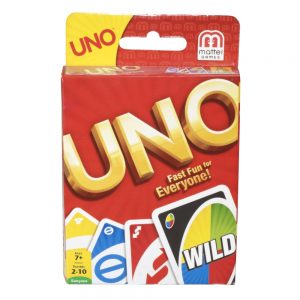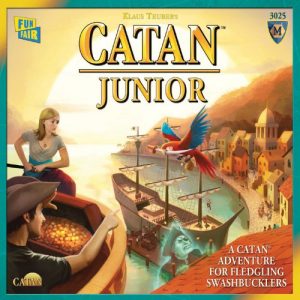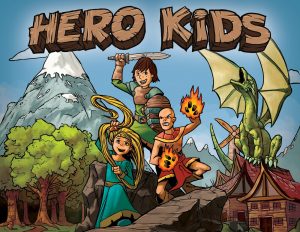
You’ve decided to establish a routine game night with the family as one of your 2016 New Year’s resolutions. We’re half-way through January… how are you coming along with meeting your goals?
It can be hard just to get everyone living in the same house together long enough to share a meal sometimes, much less for an extra-curricular event like a game night, particularly as your kids get older and other distractions demand more of their attention. Other factors can play a role in thwarting your best efforts to get a regular game night going. Chief among them tends to be the question, “Which game or games should we start with?”
We have published many articles in the past that feature great games for the youngest in the house and games that cater to adults. But what about that group in between? With three kids in our house, ranging from first grade through fifth grade, plus two parents, our biggest challenge was finding games that are simple enough for early readers, yet sophisticated enough to engage more active minds. Games that entertain kids and adults alike while laying a solid foundation for gameplay principles that we can build upon in the years to come. Games that simplify without dumbing down. Games that have a lot of replay value for the price.
Below are five games–many of which we have featured on this site in the past–that serve as a starter kit upon which you can build your game night library.

Uno
When I was about the same age that my children are now, my parents would ship me and my brother to our grandparents’ house for a week every summer. Being farmers whose own children had been out of the house for years, there weren’t many toys and games to play with (you know, not counting the hundreds of acres of pristine mid-western streams, woods, and farmland). I can only remember two… a homebrewed version of “Go Fish” created from the colored Let’s Go to the Races! tickets and a battered deck of Uno cards.
Uno is a great gateway game to get your family game night started. It is simple, yet requires players to think about both number and color. It teaches kids the proper way to handle cards, which is an invaluable skill for both Uno and for future games that you add to your game library. Strategy comes into play as players look to offload their cards while keeping others from doing the same. The game is flexible enough to allow for any creative variations of house rules. Finally, the game is infinitely replayable, as no two hands are ever the same.

Qwirkle
Sometimes, game designers fall in love. Not with one another–okay, sometimes that happens, too–but with multiple games. I can imagine a game designer sitting down with his family in much the same way you and I do, and an argument breaking out. One kid wants to play Uno. Another wants to play Dominoes. What’s a family to do?
I don’t know that the above happened, but it sure seems that something like this is what gave birth to the idea that became Qwirkle. Players draw a number of wooden tiles from a bag, then score points by creating rows of tiles. Rows might be of the same shape (all circles of different colors) or the same color (all green shapes). More tactile than Uno cards, the tiles are perfect for both child-sized and adult-sized hands. Like Uno, Qwirkle is flexible enough to allow various house rules to be created to cater to your family’s specific desires.

Blokus
Another bright and colorful game with small pieces that deliver a satisfactory tactile experience. The pieces are combinations of blocks in varying amounts, shaped into forms reminiscent of Tetris bricks. Rather than place all of your pieces into a solid layer, the idea of Blokus is to place all of your pieces on the board before your opponents place all of their pieces. The catch is that your pieces may only touch at the corners, not along any of the straight faces. This game is great for promoting geometric thinking in a two-dimensional plane, planning, and improvisation when your planned move is blocked by another player.

Catan Junior
Before you tear your family apart with disputes initiated during play sessions of the original Settlers of Catan, enjoy a few turns with this family-friendly version aimed at teaching children and the uninitiated in the basics of resource collection, trading, and building. Catan Junior features just four resources and a version of the Development Card featuring Coco the Parrot. Just try to keep your youngest player from spending all of her resources on Coco cards. No, really… just try it.

Hero Kids
Hero Kids is an excellent gateway into the wider world of tabletop roleplaying games. The set up is simple and ironic enough: while all the adults are off (presumably starring in their own tabletop gaming adventures), it falls to the kids to step up and protect their village from the usual suspects of rats, goblins, skeletons, and similar pests that frequent games in this genre. The game is fun, engaging, and teaches players the basics of dice rolls in tabletop RPGs using nothing more than whatever six-sided dice you can poach from other games lying abandoned around the house (I’m looking at you, that copy of Monopoly that is in everyone’s closet). The game features printable PDF coloring pages, so the whole family can style their individual characters however they want. Numerous expansions are available, adding more scenarios, monsters, heroes, and more onto the core game.
One could do worse than to have these five games available when beginning a family game night. Each is reasonably priced, loads of fun for kids and parents, and an excellent tool for teaching young and new players the basics of tabletop gaming. As your family masters these games and looks to expand your games library, the lessons learned and skills acquired from these core games will serve you and your family for years–and games–to come.

